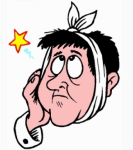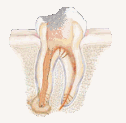
Toothache After Filling Treatments
A dental filling is a dental procedure to restore a tooth that has suffered a structural damage (due to tooth decay, fracture or other reason) and relieve you from the pain. However in some cases you may continue to experience a toothache after filling the tooth and treating the condition. Usually the discomfort is only temporary and subsides on its own, but occasionally there is a problem with the filling or the tooth and further treatment is needed.
How to stop a toothache after a dental filling?
There are several conditions that may cause persistent tooth pain after filling that will eventually need the intervention of the dentist to resolve the problem. These include:
A mild sensitivity tooth pain is normal after a dental filling procedure due to the irritation of the pulp tissue and nerves during the cavity preparation. The pain will normally stop in a few days without the need of any other treatment. In the mean time, you can ease the discomfort by:
- avoiding everything that could cause sensitivity (hot, cold, sweet foods)
- using a special toothpaste for sensitive teeth
- eating a soft diet
- taking an over the counter pain reliever
If the pain continues for several weeks or it is too intense that you need constantly toothache medication to withstand it, there is a problem with your dental filling. You should visit your dentist for examination. A number of reasons may be responsible for a persistent tooth pain after filling a tooth. Depending on the cause of the toothache, in most cases the dentist will either have to adjust or replace the filling, or to treat again the tooth usually with root canal therapy.
Treatments for Toothache After Filling
The type of toothache you experience after a filling can help the dentist to identify the possible cause of the problem, and make an accurate diagnosis and treatment planning after the physical examination.
Toothache When You Bite
If you feel the pain when you bite down, there are two main possibilities:
- incorrect bite – in this case the filling is shaped too high and the restored tooth is abnormally pressed against the tooth of the other jaw. Reshaping the filling’s surface so that it is on the same level with the rest of the teeth and its cusps on the biting surface fit to the shape of the opposite tooth, can solve the issue and stop the toothache.
- bonding failure – if the dentist fails to properly dry the filling area during the procedure, the filling material does not bond properly with the tooth. A small gap may remain between them. Similar problems may arise from other technique errors such as incomplete sealing of the cavity and from incomplete or too rapid curing of the filling material. Unfortunately there is no way to fill that gap; the filling must be removed and replaced with a new one.
Toothache When Your Teeth Touch
If you experience a sudden and sharp toothache only when you close your mouth and your teeth touch each other but not when you chew, the toothache after the filling is caused by an electric reaction between two teeth with restorations made by different metals. This type of problem affects only new silver amalgam fillings. In many cases the reaction will stop in a few days, but if it continues the only way to stop the tooth pain is to replace the amalgam filling with one made of composite material.
Constant Toothache
If the toothache is constant and persistent, becoming more aggravating when chewing, the tooth is not in a healthy condition. The pulp is probably damaged or infected by tooth decay bacteria. Having root canal therapy is necessary before the tooth is restored again with a new filling or crown.
Allergic reaction to the Filling
Although it is not a common problem, you may have a toothache after filling as a symptom of an allergic reaction to the filling material, most often when you are having a new silver amalgam filling. Replacing it with a composite filling can stop the tooth pain and any other allergy symptoms such as itching or rashes.

 Dental Insurance
Dental Insurance Tooth Abscess Pain
Tooth Abscess Pain Toothache Medicines
Toothache Medicines